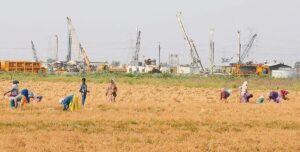Jaibans Singh

The Government of Punjab announced its Land Pooling Policy 2025 with great fanfare. The government envisaged creation of urban clusters in 27 cities of the state starting with Ludhiana where the process of acquisition of about 24000 acres of land has been initiated.
The policy elicited a sharp negative response from within Punjab. Some have termed it as a Ponzi scheme while others have said that the policy will benefit businessmen only while farmers will emerge as the worst sufferers. Fears of an economic collapse have been aired.
Farmer unions argue the policy threatens fertile, high-yield farmland without any proper survey or consultation. Protests are being planned across Punjab to resist the implementation of the policy, due to fears of corporate exploitation and long-term harm to the agrarian economy.
Farmers led by Samyukt Kisan Morcha (SKM) and Kisan Mazdoor Morcha (KMM), on July 30 held tractor marches across Punjab. Hundreds of farmers on tractors with banners against the policy held a march in various districts of Amritsar, Faridkot, Ferozepur, Jalandhar, Ludhiana, Moga, Mansa, Bathinda and Patiala.
Now, in a major setback for the Bhagwant Mann-led AAP government in Punjab, the Punjab and Haryana High Court has ordered an interim pause in the operation of the Land Pooling Policy 2025. The pause came in response to a petition filed by Advocate Gurdeep Singh Gill, a Ludhiana-based resident, who challenged the legality and constitutionality of the policy.
The youth of Punjab are going through a socio-economic crisis. Lack of credible employment opportunities and non-availability of progressive and positive pursuits has created a situation in the region, wherein, they have resorted to extensive drug abuse. As a spill-over, many have become gangsters and are indulging in lawlessness.
Legal Standing of the Policy
Doubts are being raised about the legality of the scheme. After decades of intense public pressure, the Congress led Union government passed the ‘The Right to Fair Compensation and Transparency in Land Acquisition, Rehabilitation and Resettlement Act 2013 (the Right to Fair Compensation and Transparency in Land Acquisition, Rehabilitation and Resettlement Act 2013)’, abbreviated as the LARR Act, 2013.
The Act replaced the Land Acquisition Act of 1894 which was designed to assist the British in acquiring land as per their requirement. LARR incorporates many features that protect the rights of the land owners.
- Provides compensation on acquisition that is two times the average market rate of the last three years in cities and four times in villages. The government has to declare compensation in advance for acquiring land. It can be increased through the intervention of the courts.
- Makes obtaining consent of 80 percent land owners while acquiring land for collective use and public purposes mandatory.
- Stipulates conduct of independent surveys by an autonomous body to identify the social impact
- Demands concrete plan for rehabilitation and resettlement of the displaced persons.
LARR has been amended a few times. Yet, it has endured in the BJP led Union government which points towards its universal acceptance.
After the implementation of the LARR Act 2013, governments and corporates are finding it difficult to acquire land. The Punjab government in particular cannot buy land by paying massive compensation in advance as is mandated in the Act since it has no funds available.
The Aam Aadmi Party, that is running the government in Punjab has no dearth of brilliant yet diabolic minds that can identify loopholes to pursue self-serving agendas for personal and party benefit. It is blatantly misusing a provision that allows State governments to make necessary rules under state laws while implementing the land pool policy as contained in the act.
Displacement of the Poor and the Marginalised
A major concern is about the displacement of millions of poor people for whom no resettlement plan has been offered. It is well known that most people having small holdings of agricultural land in Punjab are listed as “small and marginal framers” not working as farmers. They are, in fact, NRIs or urbanised white-collared professionals in government or corporate service with heavy earnings.
Those who are involved in agriculture take the lands of these “small and marginal farmers” on contract and increase their otherwise meagre holding into viable cultivation units. Around this concept a cycle of commerce has been built up.
On application of the Land Pooling Policy, the rich “small and marginal farmers” will walk away with the converted urban property, while the people engaged in secondary services will be ruined. Those opposing the policy have flagged the adverse effects on different sections of the society.
- Villages will be depopulated, agricultural as a profession will be wiped out and the landless labourers will lose their livelihood.
- Businesses related to agriculture like animal husbandry, dairying, vegetable/fruit cultivation etc. will closed down
- Public interest government schemes like MNREGA will be closed.
- People in non-agricultural occupations in villages, especially those providing services like tailors, barbers, motor mechanics, small shopkeepers, confectioners, cobblers etc. will become jobless and destitute.
- The age old civilisation of Punjab will disappear

Urban Infrastructure in Punjab
Another significant aspect that needs deep analysis is the requirement of urban infrastructure in Punjab. The population density in Delhi is 11,320 people per sq km and in Gurugram it is 1241 people per sq km. Such regions and cities require high-rise living and commercial structures for sustenance of the population. In Punjab the population figure stands at 551 people per sq Km only, even in Ludhiana, the most densely populated urban centre of Punjab, the density stands at 975 people per sq km. The Total fertility rate (TFR) in Punjab is 1.6, far below the replacement rate of 2.1. This indicates a declining population.
From the above data arises a relevant question- for whom are these urban centres being constructed? The people of Punjab continue to have a preference of staying in Kothis (independent houses) rather than high rise societies. There is adequate accommodation available along-with space for expansion in the many colonies that have cropped up in all cities.
- The few places like Zirakpur and Mohali where high rise societies have come up are facing a difficulty in the sale of flats.
- Many flats that have been sold remain unoccupied. There is hardly any society that has more than 70 percent occupancy.
- The new malls and high rise office spaces that have come up in existing urban clusters are finding it difficult to sell their showrooms or make the project financially viable.
People have purchased flats and commercial places probably to park their black money and other ill-gotten wealth. Many have been purchased by NRIs in order to maintain a foothold in Punjab.
Under these circumstances the future planning of infrastructure at a scale as large as the one envisaged by the incumbent government does not exhibit any financial viability.
If the state government really wishes to help the people of Punjab it should regularise the 14000 colonies which as per the data given by the government have an illegal status. These should be brought under municipal jurisdiction, made to pay taxes and developed into modern urban centres.
The government should first ensure that all available urban spaces are optimally utilised, only then should it go for further expansion.
There is a possibility that the cash strapped government is trying to create an asset that can be mortgaged to take more loans from financial institutions like the world bank. It requires the money urgently to deliver its populist promises as the elections draw closer.
Government’s Hard-sell of the Project
Despite the fault lines of the Punjab Land Pooling Policy, it is being heralded by the AAP propaganda establishment and official government channels as a heavenly opportunity for small and marginal farmers. The government is selling dreams to the people of becoming millionaires overnight. Official communiques are describing the policy as, “A flagship initiative of the Punjab government with the stated aim of promoting “planned urban development.” The government has flagged the following as benefits of the policy
The government has repeatedly emphasised the voluntary nature of the project and has assured that there will be no forced acquisition of land. It has stated that the owners will have the choice to develop the land themselves. It is also being said that the farmer can quit the scheme at the time of his choice.
However, in the first notification on the subject in Ludhiana the government has left no choice for the farmers to drop out of the scheme. This points towards a diabolical agenda.
Land Pool Models across India
The supposed land pool success in Gujarat and the creation of Amaravati, the capital city of Andhra Pradesh are being quoted by the government as perfect examples of the efficacy of the land pooling policy.
Gujarat is not an agriculture centric state like Punjab. It is, in fact, a very prosperous hub of business and industry. The state also has a fool proof system of looking after the interest of its own people. It has ensured that locals get absorbed in the industrial mainstream. A comparison between Gujarat and Punjab, therefore, is not relevant.
Amaravati was conceived with grand promises of a golden future for the landowners. The Land Pooling Scheme (LPS) under APCRDA was hailed as a revolutionary approach. It has now turned into a nightmare that has led to an existential crisis for the original inhabitants.
The developers have deducted land for common services from the pool of the participants. Hence what was to be a 600-yard commercial plot in return of an acre of land has now become less than 300 yard and is unviable for any commercial activity.
The farmers who have given a part of their land holding for the city or are getting second thoughts about the participation in the scheme are finding it difficult to return to agriculture since the geographical boundaries of the land holdings have been lost. This apart the land has lost its fertility due to the increased human signature and deficiency in water.
Land is sacred in the Culture of Punjab
Since many millenniums the people of Punjab have nurtured a special love and affinity with their land. Successive foreign invasions were thwarted to keep the autonomy of the land intact. More recently, from the 16th century onwards, Punjabis fought for their land against the mighty Mughal and Afghan Empires, defeated them after making herculean sacrifices and created the Sikh Empire. It was all done basically to safeguard their land.
Punjabis stayed at the forefront of the Independence struggle against the British in the 19th and 20th centuries. They have recorded the maximum sacrifices within India. Freeing their sacred soil from the British yoke was the primary motivation behind this struggle and sacrifice.
Conclusion
The people of Punjab are convinced that by applying the land Pooling policy, the state government aims to divest Punjabis of their land which goes against the very ethos and traditions of this proud community. They fear the conversion of cultivable land into concrete structures and suspect the policy aims to benefit corporates and land mafias rather than meet genuine development needs of the common man. It will ruin Punjab’s entire economy, trade and industry that depends primarily on agriculture. The government of Punjab needs to carry out a reassessment of the policy that is full of loopholes.